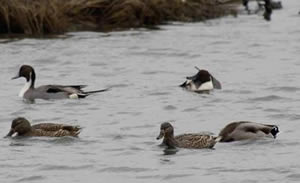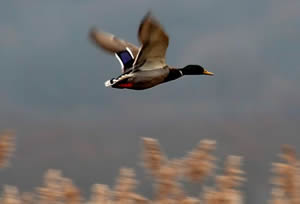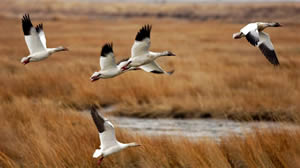2006-07 Migratory Bird Season
|
||||||||
|
Sportsmen who are willing to travel will be able to hunt ducks in at least one of New Jersey's three waterfowl zones from October 14, 2006 until January 23, 2007. If hunters also consider Canada geese, rails and snow geese, there will be potential migratory bird hunting opportunity available from September 1 through March 10. Each year, hunting regulations for migratory birds are developed by the U.S. Fish and Wildlife Service (USFWS) after input and consultation with the Atlantic, Mississippi, Central and Pacific Flyway councils. The flyway councils are comprised of representatives from state and provincial wildlife agencies that work together with the USFWS to cooperatively manage North America's migratory bird populations. Duck hunting regulations are based on biological population assessments using the Adaptive Harvest Management (AHM) process. AHM, developed by the USFWS and flyway councils, is a regulation-setting process based on science and objectivity. During 2006, the AHM process suggested that a liberal duck hunting season in all flyways was consistent with the long-term welfare of North American waterfowl populations. |
Although population models indicate that Eastern mallards, which drive duck hunting regulations in the Atlantic Flyway, can sustain these liberal seasons, there remains concern over the impact of liberal seasons on less abundant species such as black ducks, pintails and scaup. Within the near future we hope to review the impact of duck hunting regulation packages on all duck stocks in the Atlantic Flyway with our flyway partners and make any changes as necessary.
 Pintail ducks Photo by Gary Lehman - click to enlarge |
Most species of ducks in the eastern and mid-continent survey areas were near their long-term averages, although there is concern for some species. Scaup populations have remained depressed for more than 20 years and in 2006, again reached a record low of 3.2 million birds -- 37% below the long-term average. Due to the continued poor status of scaup, bag limits remain at 2 scaup per day. Although pintails remained below their long-term average, 2006 population indices increased 32% relative to last year and will again have a 1 bird per day bag limit through the 60-day duck season. |
Black ducks are a "bread and butter" duck in the Atlantic Flyway,
particularly in states with abundant salt marsh habitat like New Jersey.
Recent assessments have suggested that the harvest potential for black
ducks may be declining possibly due to a reduced breeding effort that
might be related to large scale landscape changes. Given the importance
of black ducks in the east, the USFWS, Canadian Wildlife Service,
and Atlantic Flyway partners will be examining the potential impacts
of this reduced harvest potential for black ducks over the next year.
All population indices suggest that hooded mergansers have increased
significantly across their range during the last 20 years. As a result,
the bag limit for hooded mergansers was increased from 1 to 2 birds
this year. In several regions within the US, hooded mergansers are
a popular game species.
The daily bag limit in New Jersey will be 6 ducks and may not include
more than 4 mallards (including no more than 2 hens), 4 scoters, 2
scaup, 2 wood ducks, 2 redheads, 1 pintail, 1 canvasback and 1 black
duck. Canvasbacks will be open for the duration of the duck season.
Merganser bag limits will remain at 5 birds per day although the hooded
merganser bag limit was increased to 2 birds. Merganser bag limits
are in addition to regular duck bag limits. A total of 160,000 breeding
pairs of Atlantic Population (AP) or "migrant" Canada geese were estimated
from surveys during June, 2006 on the Ungava Peninsula of northern
Quebec. This estimate is similar to 2005, although banding crews working
in the Ungava Bay region during August reported a somewhat poorer
breeding effort than expected.
The regular season for Canada geese in New Jersey will be maintained
at 45-days with a 3-bird bag limit. Additionally, the 2006 September
Canada Goose Season will be held on a statewide basis from September
1-30. This year, the bag limit was increased to 15 birds per day during
the September season. Although this bag limit change is not expected
to solve the resident Canada goose overabundance problem in New Jersey,
it is expected to provide some relief from resident goose problems
on a local scale.
The Special Winter Canada Goose Season will be held January 22 to
February 15, 2007 in two zones with the same hunt area boundaries
as last year and a bag limit of 5 Canada geese per day. Both the September
and Special Winter seasons are targeted at Resident Population Canada
geese that number about one million birds in the Atlantic Flyway.
Since Atlantic brant breed in remote wilderness of the Canadian
Arctic, their status is measured during January surveys on their wintering
grounds. In the 2006 Mid-Winter Waterfowl Survey, 146,000 brant were
counted and the most recent 10-year trend for brant shows no significant
population change. Last winter, the number of brant wintering in New
Jersey was 34% below the long-term average and was likely a response
to poor productivity in sea lettuce. As a result, brant regulations
in Atlantic Flyway states will remain conservative at 30-days with
a 2 bird bag limit.
|
Snow goose populations remain high and biologists are concerned about the impacts snow geese have on fragile Arctic nesting habitats. Serious damage to Arctic wetlands has already been documented in several key snow goose breeding colonies. This damage impacts the snow geese themselves, as well as other wildlife dependent on the Arctic ecosystem. Serious damage to agriculture also occurs in migration and wintering areas. The season length for snow geese is already 107 days, the longest allowed under the Migratory Bird Treaty Act. Bag limits will remain liberal this year with 15 snow geese per day and no possession limit. |
Online and license agent HIP certifications will cost $2.00 while telephone HIP certifications will include a shipping/handling fee and cost $5.13. HIP certifications obtained from license agents and through the telephone system will be printed on durable green license stock (DO NOT LAMINATE!) while internet HIP certifications can be printed on a home computer. Regardless of the method used for HIP certification, hunters will be able to go hunting immediately after registering. HIP certification should be carried in the hunter's license holder. HIP certifications are valid from September 1, 2006 to March 10, 2007.
Additional information on special Youth Waterfowl Hunting Days in New Jersey can be found on the this web site. Information on the status of waterfowl and habitat conditions can be viewed on the USFWS' web site at: http://migratorybirds.fws.gov/reports/reports.html.
The 2006-07 New Jersey migratory bird hunting season dates follow. The 2006-07 Migratory Bird Regulations publication will be available at Division offices, license agents and sporting goods stores throughout the state in September.
2006-07 Migratory Bird Regulations Summary (pdf, 8kb)
Harvest Information Program (HIP) Certification Information
Attention Rail, Snipe and Moorhen Hunters - Nontoxic Shotgun Shell Regulations in Effect for 2006
|
||
|
|
||
|
||
| |
||


